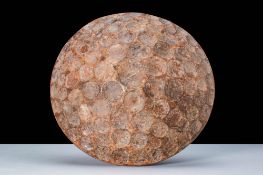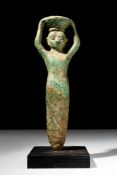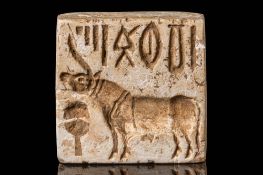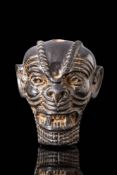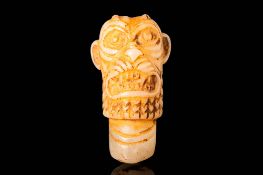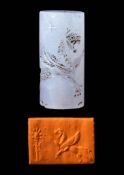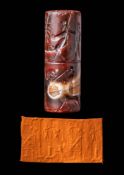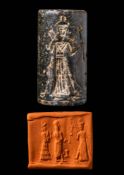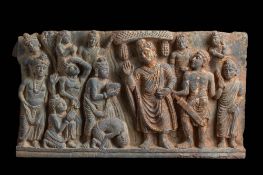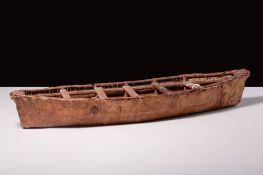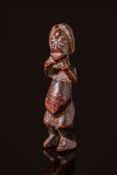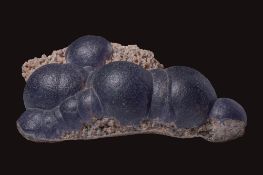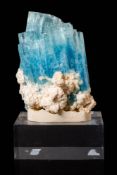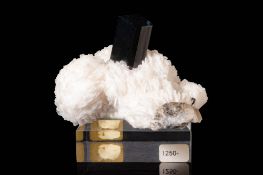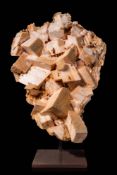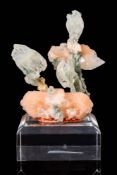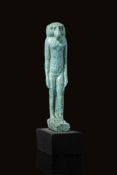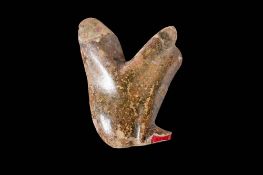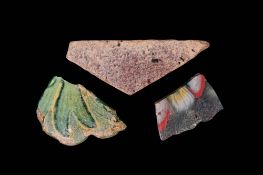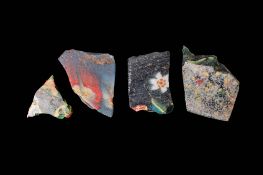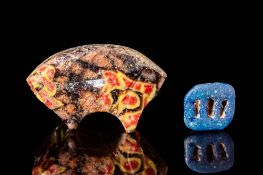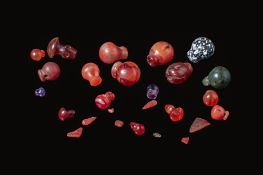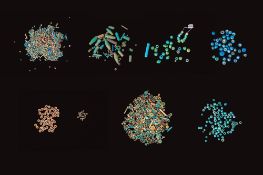Verfeinern Sie Ihre Suche
Auktionshaus-Kategorie
- Achaemenid (1)
- African Art (1)
- Amlash (1)
- Anatolian (1)
- Anglo-Saxon (2)
- Assyro-babylonian (1)
- Bactrian (2)
- Bronze Age (5)
- Byzantine (33)
- Canaanite (1)
- Canosan (1)
- Celtic (3)
- Crusaders (1)
- Cypriot (5)
- Daunian (4)
- Egyptian (150)
- Etruscan (4)
- Gandharan (4)
- Graeco-Roman (1)
- Greek (48)
- Hellenistic (13)
- Inuit (1)
- Iron Age (2)
- Merovingian (4)
- Mesopotamian (5)
- Minerals (5)
- Minoan (1)
- Mittelalterlich (26)
- Moche (1)
- Mughal (1)
- Neo-assyrian (4)
- Neoclassical (1)
- Palmyrian (1)
- Phoenician (9)
- Post-medieval (1)
- Renaissance (2)
- Roman (93)
- Romano-Egyptian (10)
- Sasanian (5)
- Scythian (4)
- Stamp seals (6)
- Syro-Hittite (1)
- Umayyad (3)
- Viking (12)
- Western Asiatic (7)
- 中文 (1)
Kategorie
- Schmuck (157)
- Präparate & Naturkundliches (86)
- Griechische, Römische, Ägyptische & andere Antiquitäten (64)
- Glas & Kristall (31)
- Varia (24)
- Skulpturen (23)
- Waffen, Rüstungen & Militaria (19)
- Großuhren (16)
- Münzen (12)
- Bücher, Manuskripte & Schriften (9)
- Metalle (9)
- Historische Baustoffe & Elemente (8)
- Keramik, Fayencen (8)
- Textilien (7)
- Spielzeug, Modelle & Puppen (5)
- China (4)
- Porzellan (4)
- Vintage Fashion (3)
- Silber & Versilbertes (2)
- Werkzeug (2)
- Wissenschaftliche Instrumente (2)
- Barometer (1)
- Ethnographie & Stammeskunst (1)
- Gemälde & Mischtechniken (1)
- Islam (1)
- Küchenutensilien (1)
- Sport Memorabilia & Equipment (1)
Künstler / Marke
- Liste
- Galerie
-
501 Los(e)/Seite
Ca. AD 1600 - 1700. A gold posy ring with a rounded exterior and a flat interior. The edges are slightly pronounced, and the exterior is textured....
Ca. AD 1600 - 1700. A gold posy ring, featuring a plain, smooth band polished to a high sheen, with a rounded exterior and a flat interior. The in...
SASANIAN CUT GLASS BOTTLE
Ca. AD 400 - 600. A glass bottle with a tall piriform body tapering to the base, a short neck, and an outward-flaring, folded rim. The exterior is...
SASANIAN STONE SHALLOW BOWL
Ca. AD 400 - 600. A shallow bowl carved from mottled reddish-brown stone, with a wide, elliptical mouth and gradually tapering walls. The exterio...
Ca. AD 700 - 900. A short free-blown glass unguentarium, comprised of brown-orange glass, with a slight concave base and a rough pontil, a globula...
Ca. AD 800 - 900. A pale greenish-blue glass bottle with a flattened globular body, flaring neck, and pronounced rim. The surface is decorated in ...
Ca. AD 1550 - 1650 . A pair of textile inlays cut into five-sided panels, each finely woven with a densely patterned battlefield scene. The compos...
NEO-ASSYRIAN GOLD PAZUZU PENDANT
Ca. 800 - 600 BC. A gold amulet in the form of the head of the demon god Pazuzu, depicted with exaggerated facial features and a fierce expressio...
Ca. 2112 - 2095 BC. A cast bronze figure with an elongated tapering body and stylised facial features, depicted standing upright with both arms ra...
Ca. 2400 - 2000 BC. A square steatite seal engraved with a left-facing unicorn, depicted with a long horn projecting horizontally from the forehe...
Ca. 2400 - 1900 BC. A square steatite stamp seal engraved on its flat face with a stylised unicorn facing left, depicted with a prominent curved ...
Ca. 800 - 600 BC. A black stone amulet in the form of the head of the demon god Pazuzu, depicted with exaggerated facial features and a fierce ex...
Ca. 1600 BC. An alabaster palette carved in the form of a stylised duck, with a rounded, hollowed interior and an arched neck curving forward int...
NEO-ASSYRIAN STONE PAZUZU HEAD
Ca. 800 - 600 BC. A stone amulet in the form of the head of the demon god Pazuzu, depicted with exaggerated facial features and a fierce expressio...
Ca. 3000 - 1000 BC. A pendant/seal carved from rock crystal in the stylised form of a duck. The neck is curved backwards along the body, with a p...
Ca. 1600 - 1500 BC. A pale translucent yellow stone scarab with a well-defined domed back and crisp delineation of the dorsal segments. The elytra...
Ca. 800 - 600 BC. A chalcedony stamp seal of octagonal pyramidal form with a slightly convex, circular base engraved with a standing figure of a p...
Ca. 8th - 6th century BC. A reddish stone cylinder seal depicting the weather god (Adad) and a worshipper, standing in front of an offering table...
Ca. 1300 - 1200 BC. A quartz cylinder seal depicting a mythical lion standing before a schematic life tree. Studied by PD Dr. habil. Pieter Gert ...
Ca. 1400 - 1250 BC. A blackish stone cylinder seal depicting human or divine figures with bird faces, alongside the symbol of Marduk and a lunar ...
NEO-BABYLONIAN TO ACHAEMENID BANDED AGATE CYLINDER SEAL WITH ROYAL HERO AND MYTHICAL CREATURES
Ca. 6th - 4th century BC. A banded agate cylinder seal depicting a complex composition, including a royal hero fighting a mythical creature, a de...
Ca. 1531 - 1000 BC. A hematite cylinder seal engraved with a scene featuring three standing figures. The central figure wears a long, flounced ro...
Ca. 8th century BC. A quartz cylinder seal depicting a hero grasping two mythical creatures, with additional animals in the exergue. Studied by P...
Ca. 1800 - 1600 BC. A black stone cylinder seal depicting a female deity standing on a lion, holding a sceptre (Ishtar), with a royal hero behind...
Ca. Early 3rd millennium BC. A black stone cylinder seal with two rows of animals and floral motifs. Studied by PD Dr. habil. Pieter Gert van der...
Ca. 3000 - 2500 BC. An amulet of white marble. The shape is a crescent with a bar raising from the centre of the inside of the crescent. There is ...
Ca. 3000 BC. An amulet of white marble. It depicts a recumbent bovine. Pierced at the base of the neck. Accompanied by a signed scholarly note by ...
Ca. 2500 - 2000 BC. A terracotta female idol with an elongated, flat body flaring at the base, and a stylised avian head with a pointed beak and ...
IRON AGE SILVER COILED BRACELET
Ca. 700 - 500 BC. A silver bracelet formed from a broad, coiled strip. The final two coils are ornamented with punched dotted motifs flanking a c...
Ca. 1500 - 1200 BC. A pair of bronze rings, each formed from a single rod coiled into two opposing spirals connected at the centre. The spirals ar...
Ca. 1000 - 800 BC. A double-edged bronze sword with a broad, tapering blade, reinforced by a central midrib and flanked by shallow fullers. The s...
Ca. 1000 - 800 BC. A cast bronze sword with a tapering, double-edged blade reinforced by a pronounced central midrib running the full length. The...
Ca. 1000 - 800 BC. A cast bronze sword with a broad, leaf-shaped blade tapering to a sharp point and reinforced by a raised central midrib. The b...
Ca. 1000 - 800 BC. A cast bronze sword with a tapering, leaf-shaped blade with a prominent central midrib extending the entire length. The blade’...
Ca. 1000 - 800 BC. A cast bronze sword with a long, leaf-shaped blade exhibiting a pronounced central midrib extending the full length. The shoul...
BRONZE AGE DAGGER
Ca. 1200 BC. A bronze dagger with a narrow, triangular blade tapering evenly to a sharp point. The blade is flat in section with slightly bevelle...
Ca. 400 -200 BC. A simple silver torc of circular form with conical termini in the shape of lion heads. The band narrows slightly between the term...
ANATOLIAN KUSURA MARBLE IDOL
Ca. 2700 - 2300 BC. A flat schematic idol carved from pale greyish marble, with a disc-shaped head set on a flaring neck and broad, rounded body....
Ca. 3rd millennium BC. A rectangular stone tray with gently flaring sides and a smoothly worked surface, carved from beige stone with natural bro...
BRONZE AGE GOLD BEADS
Ca. 1500 - 1200 BC. A strand composed of numerous small gold ring-shaped beads, each with a flat profile and circular central aperture. The beads...
Ca. AD 618 - 907. A remarkable collection of terracotta statues depicting the animals of the twelve zodiac signs. Each statue features an elongate...
Ca. AD 200 - 300. A grey schist statue of Buddha standing with his left leg slightly extended and a bent knee, adorned in a kasaya robe that casca...
Ca. AD 200 - 300. A grey schist statue of Buddha standing atop an integral rectangular pedestal. The figure's left leg is slightly extended with a...
Ca. AD 100 - 200. A Gandharan panel, possibly depicting the scene of Gift of Anathapindad, with traces of gilt on the right side. The general mea...
Ca. AD 200 - 400. A schist relief with traces of gilt, depicting Buddha in the centre, with male and female attendants on each side. For similar ...
Pre-Columbian, Ca. 650 BC. A pottery bottle in the form of an exotic fruit, modelled in reddish-brown ceramic with a ribbed surface and a rounded...
INUIT WOODEN CANOE MODEL
Ca. AD 1700 - 1900. A scale model of an umiak of classic shape. The frame is constructed from lashed wooden struts and ribs, covered with stretch...
AFRICAN WOODEN STATUE
Ca. 20th century AD. A wooden figure with an elongated head, large eyes, and pronounced lips. The arms are bent upwards with both hands touching ...
DEEP PURPLE BOTRYOIDAL FLUORITE
. A large specimen of botryoidal fluorite exhibiting a rich, deep purple hue. The surface presents smoothly rounded, bulbous formations resemblin...
BERYL V. AQUAMARINE
. A cluster of elongated aquamarine crystals with sharp vertical striations. The lower portion is partially enveloped by pale, granular mineral a...
. A lustrous, dark-green tourmaline crystal with sharply defined edges projecting from a bed of finely radiating white albite blades. To the side...
Trepca, Yugoslavia. A mineral plate with a field of pale peach-coloured dolomite rhombs, accompanied by needle-like quartz crystals. The quartz a...
PEACH STILBITE CRYSTAL CLUSTER
. A mineral specimen composed of peach-coloured stilbite crystals intersected by translucent greenish prismatic formations. Mounted on a clear di...
EGYPTIAN FAIENCE BABOON FIGURINE
Late Period, Ca. 664 - 332 BC. A turquoise-blue faience amulet in the form of a standing baboon, depicted upright with arms held closely at the s...
EGYPTIAN INLAY OF SEATED FIGURE
Ptolemaic - Roman Period, Ca. 4th century BC - 1st century AD. An inlay fragment depicting a seated figure, rendered in a semi-abstract form. The...
Ca. 332 BC - AD 200. A collection of three mosaic glass inlays with varied compositions. One inlay has a mottled purple surface, another displays...
Ca. 332 BC - AD 200. A collection of five mosaic glass inlays depicting plants. The fragments feature stylised floral motifs in yellow, white, an...
Ca. 30 BC - AD 200. A pair of mosaic glass inlays. The one on the left is a polychrome fragment formed of opaque red, yellow, and black tesserae a...
New Kingdom to Ptolemaic Period, Ca. 1550 - 30 BC. A collection of pendants in various types of stone, including carnelian, amethyst, and others....
New Kingdom to Ptolemaic Period, Ca. 1550 - 30 BC. A collection of faience beads in a variety of shapes, including ring-shaped, spherical, cylind...
-
501 Los(e)/Seite






